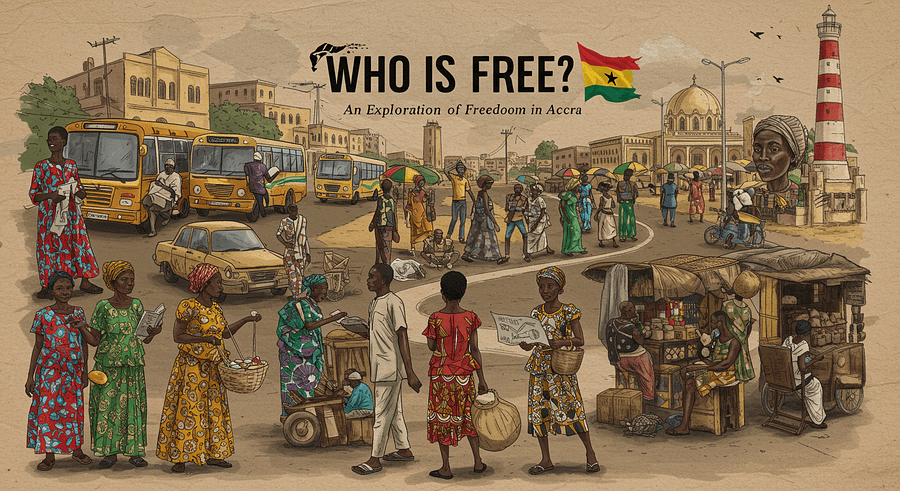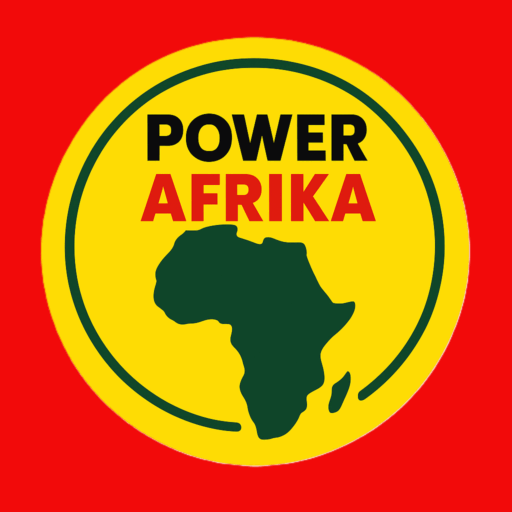
A Multifaceted Exploration Inspired by Ghana
A few years ago, while immersed in the vibrant chaos of Accra, I encountered an intriguing phenomenon that has since lingered in my thoughts. Amid the bustling tro-tro buses, animated taxis, and modest kiosks, a persistent question was etched into the urban fabric: “Who is free?” This enigmatic query, appearing everywhere as if part of a collective consciousness, stirred not only curiosity but also a profound introspection among the locals. It was as if the question itself beckoned a deeper inquiry into the nature of autonomy—a call to consider what true liberation means within the context of Ghana’s historical and contemporary realities.
That experience left an indelible mark on me. I became fascinated with the notion that freedom is not a singular, static state but a multifaceted condition that spans the spectrum of human existence. This article aims to dissect the many layers of freedom—from the grand arenas of political and economic emancipation to the intimate realms of individual and psychological liberation. In doing so, I invite you to explore with me an expansive interpretation of freedom and to reconsider the answer to that ubiquitous question: Who is free?
I. The Genesis of a Question: A Personal Reflection
In the heart of Accra, where the pulse of urban life is felt in every conversation and every shared moment on public transport, I first noticed the question “Who is free?” emblazoned on walls, vehicles, and even market stalls. This was not merely a decorative slogan; it resonated as a form of silent social commentary—a mirror reflecting the collective aspirations and latent discontents of the people. Amid the clamor of everyday life, this question evoked a deep sense of urgency, as if urging the community to reassess its understanding of liberty in a rapidly evolving society.
I remember pausing at a busy kiosk, struck by how such a simple phrase could encapsulate the struggles, hopes, and historical burdens carried by Ghanaians. It was a clarion call to question whether freedom was merely a ceremonial ideal or a tangible reality experienced by all. This personal encounter became the impetus for my exploration, as I sought to unravel the various dimensions of freedom from both a theoretical and a lived perspective.
II. Historical and Philosophical Foundations
Any exploration of freedom must begin with its roots in historical and philosophical discourse. Pioneering thinkers like John Locke championed the notion that individuals are endowed with inalienable rights—life, liberty, and property—which have become cornerstones of modern democracy. Later, Isaiah Berlin’s influential distinction between “negative freedom” (freedom from external constraints) and “positive freedom” (the capacity to act on one’s own will) has provided an enduring framework for understanding liberty in its multifarious forms. Berlin’s essay, Two Concepts of Liberty, remains a seminal work that continues to inform debates on autonomy and self-determination (Berlin, 1958).
In the African context, however, these Western frameworks intertwine with indigenous ideas and the legacies of colonialism. Ghana, like many post-colonial states, has witnessed a tumultuous journey toward genuine freedom—a journey marked by the struggle to reclaim cultural identity, achieve economic self-determination, and overcome the residual vestiges of colonial domination. Kwame Nkrumah, the visionary leader of Ghana’s independence movement, once stated, “Freedom is not something that is merely handed down; it must be continually nurtured and defended.” This sentiment encapsulates the enduring challenge of liberation, which is as much about self-empowerment as it is about structural reform.
III. Macro-Level Freedom: Political and Economic Dimensions
At the broadest level, freedom is often framed in terms of political and economic systems. Political freedom encompasses civil liberties, democratic participation, and the protection of human rights. In Ghana, the evolution from colonial rule through periods of military intervention to democratic governance has been both inspiring and tumultuous. While the establishment of democratic institutions marked a significant triumph, political freedoms are still frequently tested by economic inequalities and lingering external influences.
Economic freedom is equally critical—it refers to the ability of individuals to control their labor, capital, and resources. This facet of liberty is intricately linked to market dynamics, entrepreneurial opportunities, and the equitable distribution of wealth. Ghana’s post-independence economic narrative is a study in contrasts: political sovereignty was achieved, yet economic autonomy remains a work in progress. Prominent economists have noted, “Economic self-sufficiency forms the cornerstone of true freedom; without it, political liberties risk devolving into mere formalities” (Smith, 1999). The tension between political and economic liberation underscores the complexity of achieving holistic freedom.
IV. Meso-Level Freedom: Community and Cultural Dimensions
Descending from the grand arenas of statecraft and market forces, meso-level freedom unfolds within the tapestry of communities. It is in the everyday interactions, traditions, and social norms that the true texture of liberty is experienced. In Ghana, rich cultural heritage and communal practices offer both a source of empowerment and, at times, a framework of limitation.
Cultural rituals, indigenous festivals, and local governance systems reinforce a sense of belonging and collective identity. These practices, steeped in history and tradition, not only celebrate the community’s past but also act as a bulwark against cultural erosion. Ama Ata Aidoo, a celebrated Ghanaian writer, eloquently asserted, “Our heritage is the wellspring of our freedom; it nourishes our souls and fortifies our spirits against the tides of modernity.” Such cultural expressions serve as potent reminders that freedom is as much a matter of identity and heritage as it is of political and economic rights.
However, meso-level freedom is not without its challenges. Social hierarchies and entrenched norms can restrict individual expression, hindering personal innovation and autonomy. Yet, in public spaces like Accra’s bustling markets and community centers, the dynamic interplay between tradition and modernity creates a living dialogue about what it means to be truly free. The omnipresent question—“Who is free?”—thus becomes both a celebration of communal resilience and a call to critically reassess the social constructs that shape our everyday lives.
V. Micro-Level Freedom: Individual and Psychological Dimensions
At its most intimate, freedom is an inherently personal journey. Individual autonomy involves the capacity to make choices, express one’s unique identity, and pursue personal fulfillment without undue constraint. Yet, this personal emancipation is frequently complicated by internalized limitations and the pervasive influence of societal expectations.
The path to psychological liberation requires a continuous process of self-reflection and inner transformation. Jean-Paul Sartre’s provocative assertion that “Man is condemned to be free” encapsulates the paradox of individual freedom—it is both an opportunity and a burden. This existential perspective highlights that personal liberty is not merely about external circumstances but also about overcoming internal barriers and embracing the responsibilities that come with true autonomy.
I have witnessed firsthand the resilience of individuals who, despite overwhelming odds, strive to redefine their identity and claim their space in a complex world. In conversations with several Ghanaians, one elderly gentleman poignantly remarked, “True freedom begins in the heart; it is cultivated in moments of introspection and nurtured by the courage to challenge convention.” These personal narratives illustrate that the quest for freedom is as much about inner emancipation as it is about external achievements.
VI. Synthesizing the Spectrum: A Holistic Answer to “Who Is Free?”
The exploration above reveals that freedom is not a monolithic condition but a dynamic, multi-layered construct. At the macro level, nations may possess democratic frameworks and political rights, yet they remain susceptible to economic dependencies and external pressures. At the meso level, communities celebrate cultural heritage and collective identity even as they grapple with traditional constraints. At the micro level, individual freedom is a continuous, introspective journey, a delicate balance between self-expression and societal expectation.
Thus, the most comprehensive answer to “Who is free?” is that freedom exists on a continuum. It is neither an absolute state nor a binary condition but an evolving process that requires constant vigilance, adaptation, and renewal. True freedom is an aspirational journey—a symbiotic relationship between collective progress and personal development.
VII. A Teaching Moment: Embracing the Journey Toward Liberation
This exploration is not meant to provide a simplistic, one-size-fits-all answer. Instead, it is an invitation to view freedom as both a communal and personal mission. The African proverb, “If you want to go fast, go alone; if you want to go far, go together,” encapsulates the essence of this journey. It reminds us that while individual empowerment is vital, the strength of a society lies in its solidarity and shared commitment to progress.
In embracing this holistic view of freedom, we learn that liberation is multifaceted. It involves dismantling oppressive structures, reclaiming cultural heritage, and embarking on a relentless quest for self-discovery. Each layer—from the policies that govern nations to the intimate narratives of individual lives—contributes to the mosaic of true liberty.
For students, community leaders, and every engaged citizen, the lesson is clear: the pursuit of freedom is a lifelong endeavor. It demands both critical reflection and collective action. By continuously questioning, challenging, and reimagining the boundaries of our existence, we pave the way for a future where every individual can experience the fullness of autonomy.
VIII. Conclusion
In our inquiry into the question, “Who is free?”, we have traversed a wide-ranging landscape—encompassing historical foundations, philosophical debates, political and economic realities, cultural expressions, and personal journeys. This multidimensional exploration reveals that freedom is not an inherited or static condition but a dynamic, ever-evolving process. It is a state that must be actively pursued and nurtured at every level of society.
The answer, then, is both complex and inspiring: Freedom is an ongoing dialogue between the individual and the collective, the past and the present, the ideal and the real. It calls upon us to remain vigilant, to question the status quo, and to work collectively toward a society where every person can truly flourish. In a world marked by both extraordinary potential and formidable challenges, the journey toward liberation is a testament to our resilience and our shared commitment to building a just, equitable future.
May this exploration serve as a beacon—a teaching moment that encourages each of us to reflect on our own understanding of freedom and to contribute actively to the realization of a society where liberty is not a privilege of the few, but a birthright for all.
